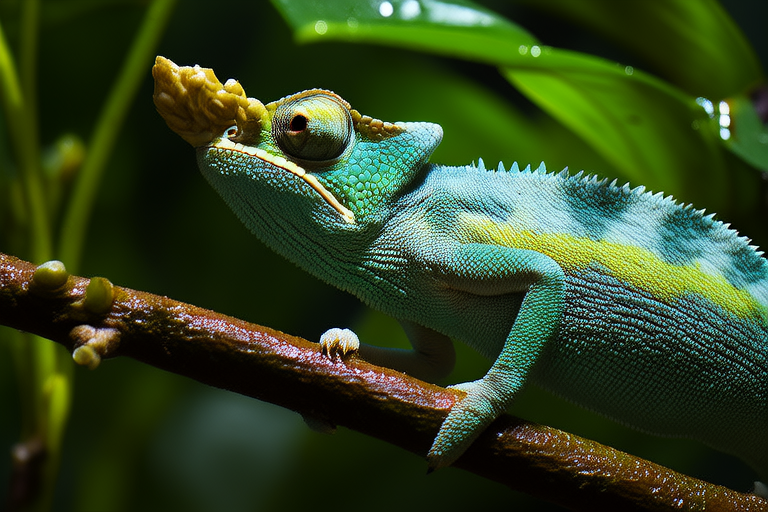The Ultimate Guide to Chameleon Care: Tips from Expert Owners
Chameleons are fascinating creatures with unique needs that make them a rewarding but challenging pet. This guide offers comprehensive advice from expert owners to help you provide the best care for your chameleon.
Habitat Setup
Creating a habitat that mimics their natural environment is crucial for chameleons’ well-being. Start with a spacious vivarium; a minimum of 24x18x36 inches for juveniles, increasing size for adults. Vertical space is more important than horizontal.
“Ensure there’s plenty of vertical space for climbing. My chameleon loves to explore high areas,” advises Sarah, a seasoned chameleon owner.
Provide branches of varying diameters for exercise and basking. Position UVB bulbs at one end to encourage natural behaviors and maintain optimal health. A daytime temperature gradient of 75-95°F and nighttime drop to 65-75°F is ideal.
“Use a digital thermometer and hygrometer to monitor temperature and humidity levels accurately. This ensures your chameleon’s environment stays within the recommended range,” recommends John, another experienced keeper.
Install misting systems to maintain humidity between 40-60%. Regular misting also encourages natural drinking behavior. Avoid overcrowding the enclosure with decorations, allowing enough open space for movement.
Diet Specifics
Chameleons are insectivores, requiring a varied diet rich in nutrients. Feed them gut-loaded insects such as crickets, dubia roaches, and waxworms. Dust these insects with calcium and multivitamin supplements twice weekly.
“I dust my insects with calcium and vitamins every other feeding. It’s crucial for bone health and overall vitality,” shares Emily, a dedicated chameleon enthusiast.
Incorporate leafy greens like collard greens, mustard greens, and dandelion leaves into their diet. These provide essential nutrients and hydration. Ensure all food items are pesticide-free and fresh.
“Always check for pesticides on greens. I grow my own to ensure they’re safe for my chameleon,” says Lisa, an expert on chameleon nutrition.
Feed adult chameleons daily, offering as much as they can eat in about 15 minutes. Juveniles may need smaller, more frequent feedings. Monitor weight and condition regularly to adjust the diet accordingly.
Health Care Basics
Regular veterinary check-ups are vital. Find a reptile-savvy veterinarian familiar with chameleon care. Signs of illness include lethargy, loss of appetite, or changes in coloration.
“Preventative care is key. I schedule annual check-ups for my chameleon. Early detection of issues can prevent serious health problems,” notes Mike, who has successfully treated his chameleon’s health issues.
Monitor for signs of metabolic bone disease (MBD), characterized by softening bones and difficulty moving. Ensure proper lighting and supplementation to prevent this common issue.
“I’ve seen many cases of MBD due to inadequate lighting. Proper UVB exposure is non-negotiable for healthy chameleons,” warns Dr. Anna, a reptile veterinarian.
Maintain a clean habitat to prevent infections. Spot-clean daily and perform a thorough cleaning every few weeks. Quarantine new additions to prevent introducing diseases.
Behavioral Insights
Understanding chameleon behavior helps create a stress-free environment. Chameleons are solitary animals that prefer privacy. Avoid handling unless necessary, as it can cause stress.
“My chameleon prefers solitude. I respect her space and only handle her when absolutely necessary,” explains Karen, a chameleon behavior specialist.
Chameleons display various colors and patterns based on mood, health, and temperature. Brighter colors often indicate good health and contentment, while duller tones might suggest stress or illness.
“Watching my chameleon change colors is fascinating. It’s a great way to gauge her mood and health,” remarks Tom, an avid observer of chameleon behavior.
Encourage natural behaviors by providing climbing structures and hiding spots. These help reduce stress and promote a healthier lifestyle.
Common Mistakes to Avoid
Avoid placing chameleons in communal enclosures. They require solitude and can become stressed in crowded conditions.
“I made the mistake of keeping two chameleons together. It was stressful for both and led to health issues,” recounts Mary, who learned the hard way.
Do not over-supplement. Excessive calcium or vitamin D3 can lead to health problems. Follow the recommended dosages carefully.
“I once overdid the supplements, causing my chameleon discomfort. Always follow the guidelines,” advises Mark, who faced this challenge.
Never use tap water without proper filtration. Chlorine and fluoride can be harmful. Invest in a water conditioner or use filtered water.
“I used tap water initially, which caused skin irritation. Now I always use filtered water,” shares Linda, who experienced this issue.
Finally, avoid placing enclosures near windows or direct sunlight. Fluctuations in temperature and light intensity can stress your chameleon.
Conclusion
Caring for a chameleon requires dedication and knowledge. By following the tips from expert owners, you can provide a nurturing environment that promotes health and happiness. Remember, the closer you mimic their natural habitats, the better your chameleon will thrive.
